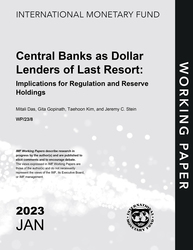
Central Banks as Dollar Lenders of Last Resort: Implications for Regulation and Reserve Holdings
Central Banks as Dollar Lenders of Last Resort: Implications for Regulation and Reserve Holdings
READ MORE...
Volume/Issue:
Volume 2023
Issue 008
Publication date: January 2023
ISBN: 9798400231049
$20.00
Add to Cart by clicking price of the language and format you'd like to purchase
Available Languages and Formats
| English |
Prices in red indicate formats that are not yet available but are forthcoming.
Topics covered in this book
This title contains information about the following subjects.
Click on a subject if you would like to see other titles with the same subjects.
Banks and Banking , Finance , Economics- Macroeconomics , Economics / General , Foreign reserves , central banks , currency mismatch , lender of last resort , financial regulation , dollar reserve , bank borrowing , post dollar lender of last resort , dollar interest rates , reserve holding , International reserves , Banking crises , Currency mismatches , Reserves accumulation , Exchange rates , Global
Also of interest
Summary
This paper explores how non-U.S. central banks behave when firms in their economies engage in currency mismatch, borrowing more heavily in dollars than justified by their operating exposures. We begin by documenting that, in a panel of 53 countries, central bank holdings of dollar reserves are significantly correlated with the dollar-denominated bank borrowing of their non-financial corporate sectors, controlling for a number of known covariates of reserve accumulation. We then build a model in which the central bank can deal with private-sector mismatch, and the associated risk of a domestic financial crisis, in two ways: (i) by imposing ex ante financial regulations such as bank capital requirements; or (ii) by building a stockpile of dollar reserves that allow it to serve as an ex post dollar lender of last resort. The model highlights a novel externality: individual central banks may tend to over-accumulate dollar reserves, relative to what a global planner would choose. This is because individual central banks do not internalize that their hoarding of reserves exacerbates a global scarcity of dollar-denominated safe assets, which lowers dollar interest rates and encourages firms to increase the currency mismatch of their liabilities. Relative to the decentralized outcome, a global planner may prefer stricter financial regulation (e.g., higher bank capital requirements) and reduced holdings of dollar reserves.
Copyright © 2010 - 2025
Powered by:
AIDC



